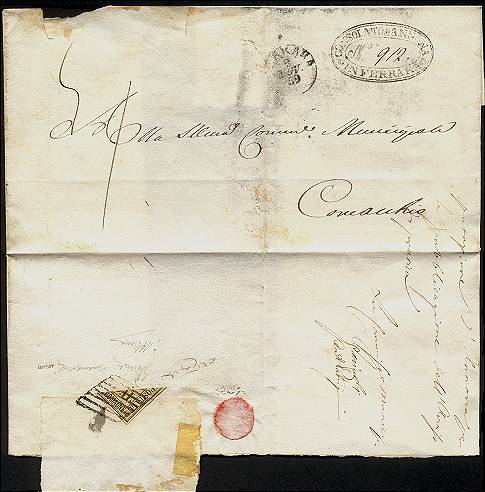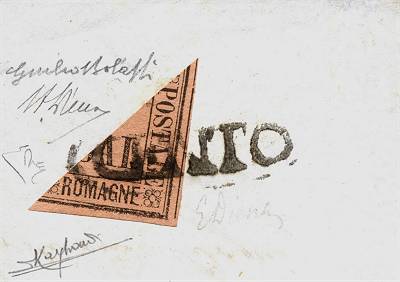I
have discussed the theme of the "bisect" stamps of the Roman
States (see related "Going deep"): I would like to complete
here the subject with the Romagne, due to the close historic relationship
between the two territories.
I already explained what they are and what is the origin of these "mutilated"
stamps: to overcome, by cutting the stamp, the temporary shortage of a specific
value.
Please see the "Going deep" relative to the Roman States
for common further details that I will not repeat therefore here.
Several pieces of the Romagne issues are known used as split ones: they are
always pieces quite rare if not very rare, much less frequent anyway of the
"parents" from Roman States.
We know the values of half Baj, 2, 3, 4, 5, 6 and 8 Baj split in two (both
vertically and diagonally) and of a 3 Baj split by 2/3. The two extreme dates
of use of the split ones are October 12 1859 (2 Baj) and March 1st 1860 (8
Baj).
I show here a nice document with a used split stamp (Fig. 1) and a
fragment (Fig. 2).

Fig. 1:
a
2 Baj diagonally split by two to obtain the fee of 5 centesimi...
In fact the Italian currency introduction established the exchange rate 1
Baj = 5 centesimi
On the front of the letter is indicated a fee due in Bajocchi (vertical number
"1")
as well as the corresponding fee in centesimi of Lira (number "5"
at top left)
that was supposed to be collected at the arrival (the stamp is in fact added
to the back of the letter and, as already saw for the Roman States,
that means a fee to be paid by the receiving party). This document is an example
of what is meant for Postal History and for "study" of the franking....

Fig. 2: a 4 Bajocchi diagonally cut in two